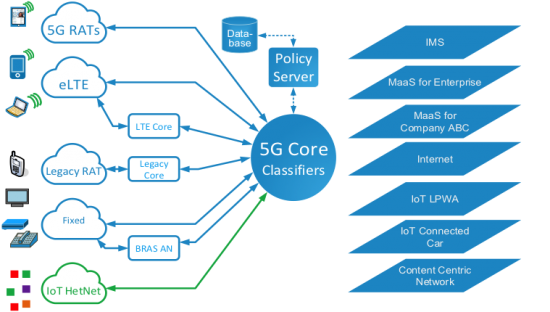































Three Keys to Success Preparing Your Mobile Network for 5GDownload our new 5G ebook
The concept of slicing is a fundamental component of the 5G architecture and it permits network customization that can reach a personal level. One could call this the personalization of the mobile internet. We can do this by taking the slicing concept to a granular level not seen before by combining three main technologies of control and user plane separation (CUPS), virtualization and end to end automation.
By adopting the new architecture of CUPS, and moving to an NFV deployment and enabling automation for many of the typical operations, not only will the current service provider's subscribers gain a richer suite of services, new opportunities and business models become available.

Figure 1 A 5G capable core can cross connect multiple access to multiple applications
Mobility standards bodies have agreed that separation of control plane and user plane shall be a corner stone of the 5G architecture. Service providers need not wait for standards though and can start deploying this architecture to address existing and new opportunities. For example, we now have the option to scale the user plane orthogonally from the control plane which significantly reduces the integration work needed to introduce a new network element.
Network Function Virtualization has received mixed press recently as the benefits of the technology are not always clear to see. However, when we consider 5G, slicing and the need to connect multiple access technologies with diverse customers, the need for a homogenized platform to deploy and manage the network functions becomes paramount.
Automation is the final key to the path to 5G and opens up a world of possibilities. Lifecycle and service configuration automation allow service providers to concentrate on innovating new applications for their diverse customers rather than worrying about integration issues. Automation simplifies an already complex network that is further complicated by separating out the user plane from the control plane and the exposure of the VNF virtual machine building blocks. By taking full advantage of the ETSI MANO framework Cisco's automation solutions hide the complexity and management difficulty of an NFV deployment. Cisco's automation also extends to service configuration by abstracting the configuration to a model rather than a node specific configuration file that requires manual handling.
The simplification of node introduction has another overlooked yet positive consequence. Not only can we make the nodes more specialized, but we can make them smaller and even consider service chaining micro-services. The control plane will still maintain state and standard signaling interfaces to the RAN and subscriber databases, while the user plane and the IP services that compliment it are now software entities that are managed and controlled by the automation suite working alongside the control plane.

The user plane is under control from the upper control layers and the service automation, allowing that critical function to be distributed, to be reduced in size to reduce failure domain, and enable the introduction of micro-services in totally new environments.
For more information on 5G download our new, ebook and see our 5G White Paper Series here.
 Etiquetas calientes:
movilidad
Service Provider
Móvil móvil
5G
Red red
NFV
Control and User Plane Separation (CUPS)
Slicing
Ultra
Etiquetas calientes:
movilidad
Service Provider
Móvil móvil
5G
Red red
NFV
Control and User Plane Separation (CUPS)
Slicing
Ultra